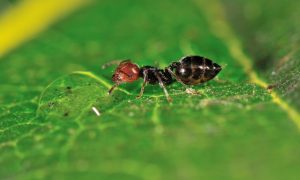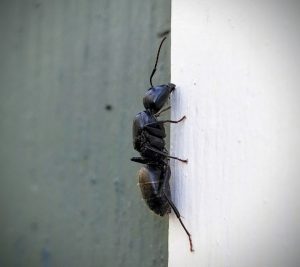Acrobat ants might make you flip out!
By Chris Williams on March 29, 2019.
I didn’t see this species at all last summer but throughout my tenure in this industry, I usually have at least a couple clients troubled by these odd little ants. I’ll classify them as a structure infesting ant. I’ve seen them excavating out foam insulation in walls and ceilings and have found them nesting under insulation in attics. This is right out of the carpenter ant playbook! Are acrobat ants related to carpenter ants? The answer is no, they’re in a completely different genus called Crematogaster.

Crematogaster scutellaris on green leaf. Shuttertsock.
There a six or so species in the US and they are quite a bit smaller than carpenter ants and range in size from 1/16 to 1/8 inch long. They are typically brownish black in color although there are some multi-colored species too. These ants are monomorphic (all same size) with two nodes separating the thorax and abdominal segments.

Carpenter Ant (Camponotus Pennsylvanicus). Z. Ciras
By contrast, carpenter ants are polymorphic with a single node. One key identifier of this species is their unique heart shaped abdomen. Acrobat ants form strong trails when foraging. Inside the home they may infest water damaged wood or foam insulation. Initial signs of infestation may include frass being pushed out of the nest site which can be mistaken for carpenter ant activity, but the texture of this material is much finer than is typical for carpenter ants. What makes acrobat ants acrobatic you may be asking? When they are disturbed (as in attacking their nest) they’ll scurry around while raising their abdomen over their thorax. Are acrobat ants making you flip out? Call the pro’s at Colonial Pest Control.